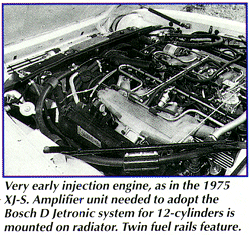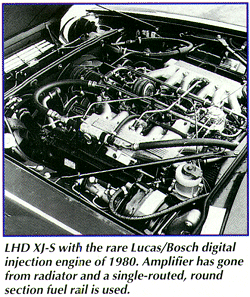|
|
 |
[ Main ] [ 1 ] [ 2 ]
[ 3 ] [ 4 ] [ 5 ] [ 6 ] [ 7 ] [ 8 ] [ 9 ] [ 10 ] [ 11 ] |
|
At this point a slight diversion is necessary because in the early 1970s a
couple of 4 valve V12s were built, one for road use, the other as a
potential race unit. These were modern narrow valve angle designs and the
race version was soon developed to produce a very impressive 630 b.h.p.
from 5.3 litres using a standard crankshaft. The one and only prototype was
loaned to TWR in the 1980s for them to study prior to producing their own 4
valver. Unbelievably, after they had stripped it and looked it over they
threw it in a skip. One has to wonder if there is a scrap man somewhere who
recognised what it was and saved it from the furnace. If so, perhaps it may
yet turn up but what value would be placed on such an engine now?
As the 1970s progressed the thirst of the V12, even with electronic fuel injection, became a matter for serious concern and a number of ways to improve it were tried. Stratified charge pre-combustion chambers were in fashion and some low key experiments took place with devices which screwed into the spark plug hole of a single cylinder test engine. Another experiment which made no headway was a small inlet port concept intended to generate stronger turbulence. Ceramic coatings on heads and pistons to both reduce friction and cut heat loss showed some promise, but of course the real problem had been identified correctly by Keith Duckworth some years before - the flat head combustion chamber design was just not good enough. Only a substantial improvement would be worthwhile yet a major redesign was out of the question, so how could it be achieved? It so happened that around this time a Swiss engineer called Michael May was claiming some impressive results from a high turbulence combustion chamber based on the conventional 2 valve in-line configuration then in widespread use. Most manufacturers looked into it without finding any great advantage but it arrived just in time to save the Jaguar V12. The rather unimaginatively named May "Fireball" combustion chamber (Fig. 3) consisted of a more or less circular pocket around and under the exhaust valve. The essential feature was that squish action created as the, now flat-topped, piston approached the cylinder head, was directed by a channel from around the inlet valve to impinge tangentially into the chamber to generate a strong swirl effect under the exhaust valve. With the spark plug relocated to the side of this chamber, the entire concept was a clever interpretation of accepted wisdom for burning lean mixtures at high compression ratios. One might easily argue that any combustion chamber design which generated some much needed turbulence in part throttle conditions would have done the trick but there can be no doubt that the May design, aided by a judicious raising of the differential gearing, transformed the fuel efficiency of the V12 and ensured its survival. Some prototype engines ran at diesel-like compression ratios of more than 14:1, but 12.5:1 was decided on for the introduction in 1981 of the "HE V12" as it was christened. The May combustion chamber design continued for the remainder of the production life of the V12 with the compression ratio lowered later to 11.5:1 for catalyst engines and finally to 11:1, lower compression ratios giving a vital benefit of quicker catalyst light up. |

|
| [ Main ] [ 1 ] [ 2 ] [ 3 ] [ 4 ] [ 5 ] [ 6 ] [ 7 ] [ 8 ] [ 9 ] [ 10 ] [ 11 ] |
Email aj6engineering@ntlworld.com, Tel/Fax:- 0044 (0)1625 573556 |

